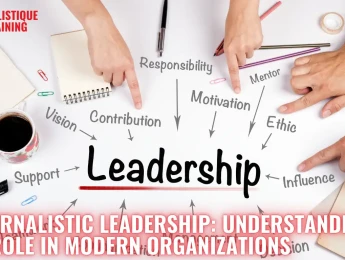- Table of Contents
- The Importance of Effective Communication in a Remote Workplace
- Fostering Connection in Isolation
- Bolstering Engagement and Productivity
- Minimising Misunderstandings
- Building Trust and Transparency
- Enhancing Problem-Solving
- Supporting Work-Life Balance
- Enabling Effective Leadership
- Promoting Inclusivity and Diversity
- Driving Innovation
- Adapting to Changing Realities
- 12 Tips for Effective Communication in the Remote Workplace
- 1- Leverage the Right Tools
- 2- Set Clear Communication Norms
- 3- Define Availability Expectations
- 4- Optimise Video Conferencing
- 5- Regular Check-ins are Vital
- 6- Encourage Active Listening
- 7- Master Written Communication
- 8- Foster Informal Connections
- 9- Provide Constructive Feedback
- 10- Champion Inclusivity
- 11- Celebrate Successes
- 12- Cultivate Flexibility and Empathy
- The Future of Workplace Communication
- Virtual Reality and Augmented Communication:
- Mindfulness and Communication:
- Data-Driven Communication Analysis:
- Hybrid Collaboration Models:
- Emotional Intelligence in Communication:
- Dynamic Communication Platforms:
- Global and Multilingual Communication:
- Continuous Learning and Adaptation:
- Conclusion
Introduction
The sands of time continually reshape the landscapes of our professional interactions. Today's dynamic work environment stands testament to this evolution, particularly in the wake of remote work's meteoric rise. The profound shift toward remote work, expedited by the global pandemic, has not only altered our physical workspaces but also redefined the very essence of workplace communication.
In this blog post, we embark on a journey that transcends the boundaries of conventional communication norms. We delve into the intricacies of effective remote communication, bridging the gap between the paradigms of pre- and post-COVID-19 realities. Join us as we navigate the uncharted waters of this new normal, exploring how the mastery of remote communication can forge stronger bonds of collaboration, elevate individual and collective productivity, and ultimately shape the trajectory of the future of work.
The Importance of Effective Communication in a Remote Workplace
The remote workplace has emerged as an enduring reality in the post-pandemic world, and its success hinges on effective communication. Understanding the significance of this transformation is essential for organisations to thrive in this new era of work. Here are key reasons why effective communication holds a pivotal role in the remote workplace:
Fostering Connection in Isolation
In the remote setup, the absence of physical proximity can breed feelings of isolation and detachment. Effective communication acts as a bridge, creating virtual spaces where team members can interact, share ideas, and establish personal connections. These interactions not only mitigate the sense of isolation but also cultivate a strong sense of belonging, crucial for team cohesion and morale.
Bolstering Engagement and Productivity
Engaged employees are the lifeblood of any organisation. Clear, consistent communication of goals, expectations, and project updates empowers remote team members to stay focused and motivated. It aligns their efforts with the organisation's objectives, fostering a sense of purpose. The sense of connectivity that robust communication provides translates directly into heightened productivity. Teams are more likely to excel when they are well-informed, motivated, and working towards common goals.
And the numbers agree. The 2020 Connected Culture Report, mentioned in an article byPumble, encompassed insights from a survey of over 4,000 knowledge workers across four countries, delved into their productivity, well-being, and team connectivity experiences. Among the respondents, 8.6% noted heightened productivity resulting from the transition to remote work during the COVID-19 pandemic. Furthermore, a substantial 71% of these employees expressed a greater sense of connection with their fellow colleagues.
Minimising Misunderstandings
In virtual interactions, the absence of non-verbal cues can lead to misunderstandings. Effective communication practices become critical tools for navigating this challenge. Encouraging team members to ask for clarification, actively listen, and provide clear, concise written messages significantly reduces the chances of misinterpretation. Clarity becomes the cornerstone upon which successful collaborations are built.
Building Trust and Transparency
Trust is the bedrock upon which successful teams are constructed. Regular, transparent communication creates a window into each team member’s roles, contributions, and challenges. When everyone is aware of each other’s responsibilities and progress, it fosters trust. Transparency in communication not only assures team members of the organisation's integrity but also encourages openness and honesty, vital elements in maintaining a positive work environment.
Enhancing Problem-Solving
Remote teams face unique challenges that demand innovative solutions. Effective communication nurtures an environment where team members feel comfortable sharing ideas and solutions openly. Open dialogue, brainstorming sessions, and collaborativeproblem-solving become possible when communication channels are clear and accessible. The diversity of perspectives, often amplified in remote teams comprising individuals from various cultural backgrounds, leads to more effective and creative problem-solving approaches.
Supporting Work-Life Balance
One of the primary challenges of remote work lies in balancing professional responsibilities with personal life. Effective communication comes into play here by setting clear expectations regarding work hours, availability, and response times. When these boundaries are respected, team members can manage their time effectively, preventing burnout and ensuring a healthy work-life balance. Acknowledging the personal lives of team members and respecting their downtime fosters loyalty and commitment to the organisation.
Enabling Effective Leadership
Leadership in a remote environment demands heightened communication skills. Leaders who communicate transparently and consistently provide a sense of direction for the team. Through regular updates, encouragement, and active listening, leaders inspire confidence among team members, especially during uncertain times. Effective leaders are not just conduits of information but also pillars of support, guiding their teams through challenges and celebrating victories together.
Promoting Inclusivity and Diversity
Remote work transcends geographical boundaries, bringing together individuals from diverse cultural, linguistic, and professional backgrounds. Effective communication practices ensure that every team member, regardless of their location or background, has equal opportunities to contribute. By valuing and accommodating diverse communication styles and cultural norms, teams become more inclusive, tapping into the wealth of varied perspectives to drive innovation and creativity.
Driving Innovation
Innovation thrives in an environment where ideas flow freely and are welcomed from every corner. Remote teams, by their very nature, bring together a wealth of diverse perspectives from different regions and cultures. Effective communication encourages the exchange of ideas, insights, and experiences. This cross-pollination of thoughts often leads to groundbreaking, cross-cultural innovations. Remote work, with its ability to connect minds across continents, becomes a hotbed for creative solutions and novel approaches to challenges.
Adapting to Changing Realities
The landscape of work is continually evolving. Effective communication strategies are not static; they evolve to suit changing circumstances. Whether teams transition back to the office, continue remote work, or adopt hybrid models, a strong foundation in communication remains the cornerstone of success. Teams that can adapt their communication strategies to align with the evolving needs of the organisation are better equipped to navigate any changes, ensuring seamless collaboration regardless of the work environment.
Table 1: Key aspects of effective communication in remote work
In essence, effective communication in the remote workplace is not merely a tool but a cornerstone upon which resilient, productive, and innovative teams are built. It nurtures connections, fosters engagement, builds trust, and empowers teams to tackle challenges and seize opportunities in the ever-changing landscape of the modern workplace. Organisations that prioritise and master the art of remote communication lay the foundation for enduring success, fostering a work culture that thrives regardless of physical boundaries.
12 Tips for Effective Communication in the Remote Workplace
The transition to remote work has revolutionised the way we communicate, challenging us to rethink traditional methods and embrace new strategies. However, according to Gallup's2022 State of the Global Workplace Report, a mere 13% of the 31 million surveyed employees reported that their leaders demonstrated proficiency in effective workplace communication. So, for you to gain an edge over your competitors and excel in this virtual realm, where face-to-face interactions are limited, mastering the art of remote communication is essential. Here are 12 practical tips that will help you enhance communication in your remote workplace:
1- Leverage the Right Tools
The digital landscape offers a plethora ofcommunication tools, each designed to cater to specific needs. Video conferencing platforms like Zoom and Microsoft Teams facilitate face-to-face interactions, fostering a sense of presence. Instant messaging apps such as Slack and Microsoft Teams enable real-time communication, enhancing collaboration on projects. Collaborative document editors like Google Docs and Microsoft 365 allow team members to work simultaneously on documents, encouraging seamless cooperation. Choosing the right mix of tools that align with the team's requirements is the first step towards effective communication.
2- Set Clear Communication Norms
Ambiguity is the enemy of effective communication. Establishing clear guidelines on when and how to use specific communication channels eradicates confusion. Documenting these norms ensures that every team member understands the protocols, preventing miscommunication and ensuring that information reaches the intended recipients accurately and promptly.
3- Define Availability Expectations
Remote teams often span across different time zones, making it imperative to set expectations regarding availability. Clearly communicate working hours, response times, and preferred methods of communication. This clarity fosters effective collaboration, enabling team members to plan their tasks and interactions accordingly.
4- Optimise Video Conferencing
Video conferencing bridges the gap between in-person and virtual interactions. While it adds a personal touch, it's crucial to use it judiciously. Reserve video meetings for discussions that benefit from visual cues and personal connections, ensuring that team members do not succumb to the fatigue of excessive screen time. Scheduling these meetings at mutually convenient times, accommodating various time zones, enhances participation and engagement.
5- Regular Check-ins are Vital
Regular team meetings serve as the lifeblood of remote communication. These check-ins provide opportunities to review ongoing projects, address concerns, and share updates. Scheduled at consistent intervals, they foster camaraderie among team members, ensuring that everyone is on the same page. Encouraging active participation and open discussions during these meetings nurtures a collaborative spirit within the team.
6- Encourage Active Listening
Remote communication isn't merely about speaking; active listening holds equal importance. Encourage team members to ask questions, seek clarification, and engage in meaningful discussions that go beyond surface-level interactions. Actively engaging with colleagues' ideas and concerns not only fosters understanding but also strengthens interpersonal relationships, laying the foundation for a harmonious working environment.
7- Master Written Communication
In the absence of face-to-face interactions, written communication takes centre stage. It is essential to convey messages clearly and effectively through written mediums. Use precise and concise language, employ appropriate formatting like bullet points and headings, and proofread communications meticulously. Clarity in written communication ensures that instructions are comprehensible, reducing the chances of misunderstandings.
8- Foster Informal Connections
Remote work, by its nature, can feel isolating. To counter this, create virtual spaces for casual conversations. These spaces mimic the spontaneous water-cooler chats of traditional offices, fostering a sense of belonging and community. Virtual coffee breaks, chat rooms for non-work-related discussions, and team-building activities contribute to a positive team culture, reinforcing personal connections despite physical distances.
9- Provide Constructive Feedback
Feedback, when delivered thoughtfully, fuels growth. When providing feedback, be specific and constructive. Point out what was done well and offer actionable suggestions for improvement. Positive reinforcement acknowledges good work, boosting morale, while constructive criticism guides team members toward excellence. Regular feedback sessions, both individual and collective, cultivate an environment of continuous improvement and mutual support.
10- Champion Inclusivity
In diverse remote teams, inclusivity becomes paramount. Be mindful of different communication styles and cultural norms prevalent among team members. Encourage open discussions where everyone's input is valued, ensuring that quieter voices are heard. Embrace diverse perspectives, as they often bring innovative solutions to the table. Cultivating an environment where everyone feels respected and valued fosters a sense of belonging, stimulating creativity and collaboration.
11- Celebrate Successes
Acknowledging achievements, regardless of their magnitude, is vital in remote work environments. Celebrate milestones, project completions, and individual successes. Establish dedicated platforms, like Slack channels or team meetings, for sharing wins. Virtual applause, commendations, and shout-outs during team meetings create a positive atmosphere, boosting team morale and motivation.
12- Cultivate Flexibility and Empathy
Remote work comes with its unique set of challenges, including varying time zones, family obligations, and differing work environments. Cultivate a culture of flexibility and empathy, acknowledging that each team member's situation is different. Be understanding of personal circumstances, accommodating where possible, and adapting expectations accordingly. This empathetic approach not only strengthens team bonds but also nurtures a supportive work environment where everyone feels valued and understood.
By integrating these twelve tips into their daily interactions, individuals and teams can craft seamless, effective communication strategies in the remote workplace. These strategies not only bridge the physical gaps but also foster a collaborative, inclusive, and innovative environment where every team member feels empowered to contribute their best, regardless of their location. Effective communication, when cultivated as a cornerstone of remote work, paves the way for enduring success and unparalleled team synergy.
The Future of Workplace Communication
As the global work landscape continues to evolve, adaptability has emerged as the cornerstone of future workplace communication strategies. In this section, we explore innovative approaches and technologies that not only adapt to the changing realities of work but also shape the future of communication in professional settings.
Virtual Reality and Augmented Communication:
Embracing cutting-edge technologies such as virtual reality (VR) and augmented reality (AR) transforms remote interactions into immersive experiences. VR tools enable individuals to participate in virtual meetings as avatars, creating a sense of presence and enhancing engagement. AR applications, on the other hand, overlay digital information onto the real world, allowing for interactive and dynamic presentations. By incorporating these technologies, teams can bridge the physical gap between members, fostering a more profound sense of connection and collaboration.
Mindfulness and Communication:
Integrating mindfulness practices into communication strategies brings a holistic approach to workplace interactions. Mindfulness techniques enhance focus, active listening, and empathetic understanding. By encouraging team members to be present in the moment, mindful communication reduces misunderstandings and fosters deeper connections. Mindfulness training sessions and meditation breaks can be incorporated into the workday, promoting mental well-being and enhancing the quality of virtual interactions.
Data-Driven Communication Analysis:
The future of workplace communication is increasingly data-driven. Analysing communication patterns through advanced analytics provides valuable insights into team dynamics. Data can identify communication gaps, highlight successful collaboration methods, and pinpoint areas for improvement. By leveraging this information, organisations can refine their communication strategies, ensuring continuous growth and effectiveness. Additionally, artificial intelligence (AI) tools can process vast amounts of communication data, offering real-time feedback and suggestions to enhance the quality of interactions.
Table 2: Comparative analysis of communication tools
Communication Tool | Advantages | Disadvantages |
Video Conferencing Platforms | Facilitate visual cues and personal connections | Requires stable internet connection |
Instant Messaging Apps | Real-time communication, quick responses | May lead to information overload |
Collaborative Document Editors | Simultaneous collaboration, version control | Limited to text-based communication |
Virtual Reality Tools | Immersive experience, enhanced team bonding | Requires specialised equipment and expertise |
Augmented Communication Tools | Enhance visual communication, interactive elements | Limited adoption, potential technical challenges |
Data Analytics Software | Provides insights into communication patterns | Requires data interpretation and analysis skills |
Hybrid Collaboration Models:
The rise of hybrid work models, where employees split their time between remote and in-office work, necessitates adaptable communication approaches. Organisations need to establish seamless integration between physical and digital workspaces. Hybrid collaboration tools, which combine video conferencing, cloud-based document sharing, and virtual project management, facilitate smooth communication regardless of employees' locations. Strategies that prioritise inclusivity, ensuring that both in-office and remote team members have equal participation and access to information, are crucial for successful hybrid collaboration.
Emotional Intelligence in Communication:
As communication becomes more digital, the human touch becomes paramount. Emotional intelligence, the ability to recognise and understand emotions in oneself and others, plays a pivotal role in effective communication. Embracing emotional intelligence skills, such as empathy, active listening, and conflict resolution, creates a positive communication culture. Training programmes focused on emotional intelligence empower employees to navigate complex interpersonal dynamics, fostering strong relationships and reducing miscommunications.
Dynamic Communication Platforms:
The future of workplace communication lies in platforms that adapt to diverse communication styles and preferences. Dynamic communication platforms offer a range of communication channels, from instant messaging and video conferencing to voice messages and interactive forums. These platforms allow team members to choose the mode of communication that best suits the context and their comfort level. Additionally, integrated project management features, document collaboration, and AI-driven chatbots enhance productivity, making these platforms central hubs for remote and hybrid teams.
Global and Multilingual Communication:
The global nature of many businesses necessitates effective multilingual communication. Language barriers can hinder collaboration and create misunderstandings. Future workplace communication strategies must embrace multilingual tools and translation technologies to facilitate seamless communication across diverse linguistic backgrounds. AI-driven language translation tools enable real-time translation of conversations, breaking down language barriers and promoting a truly global and inclusive work environment.
Continuous Learning and Adaptation:
The pace of technological advancements requires a commitment to continuous learning and adaptation. Organisations must invest in training programmes that equip employees with the skills needed to navigate evolving communication technologies. Encouraging a culture of learning and experimentation empowers employees to explore new tools and methods, fostering innovation and ensuring that the organisation remains at the forefront of effective communication practices.
In summary, the future of workplace communication hinges on adaptability and innovation. Embracing emerging technologies, nurturing emotional intelligence, fostering inclusivity, and promoting continuous learning are key pillars in shaping communication strategies for the digital age. By remaining agile and open to change, organisations can create communication ecosystems that empower teams to collaborate seamlessly, regardless of physical distances, and thrive in the dynamic, ever-evolving landscape of the modern workplace.
Conclusion
As we embrace the future of workplace communication, the mastery of remote communication becomes paramount. By integrating these strategies, organisations can foster a cohesive and thriving remote workplace. Effective communication ensures that team members remain connected, engaged, and empowered to collaborate effectively—whether they work together in a shared office or across different corners of the world. In the dynamic landscape of the modern workplace, adaptability and effective communication are the cornerstones of success. Embrace these principles, and you'll not only navigate the new normal but thrive in it, fostering a future where remote collaboration knows no bounds.
And as you embark on this transformative journey, make sure to check out our course, ‘Perfecting Your Management and Leadership Skills.’ This comprehensive programme is meticulously designed to equip you with the expertise needed to navigate the complexities of remote work, harnessing the power of communication, leadership, and adaptability. By enrolling in this course, you're not just investing in your professional development; you're ensuring that you're at the forefront of the future of work, ready to lead your teams with confidence and expertise. Embrace the future with us, and let's shape the way forward together. Enrol now!























